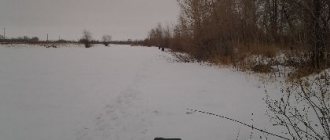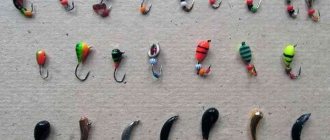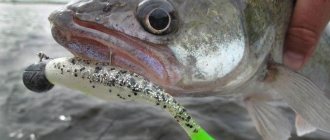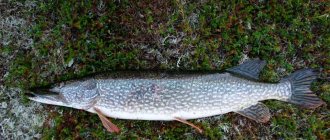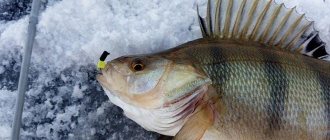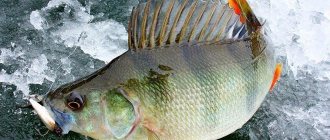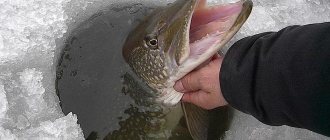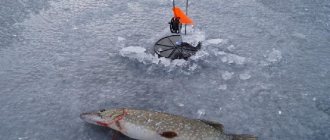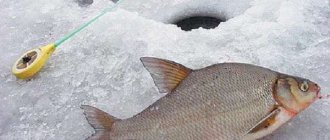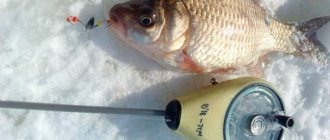Perch fishing on lakes
On deep natural lakes there is enough large perch under 2 kg, especially good catches are observed in early autumn. As a rule, the bottom of natural lakes is flat, there are practically no edges, hillocks, or boulders. There is nothing special to attach to, you have to check point by point. The only tip is that humpbacks only bite on a hard bottom, sandy with admixtures of hard gley, and there are very few bites in muddy areas. The main working depths are 4-5 m, with the existing maximum depths being 10-11 m. Perch from a kilogram and above responds well to small (5 cm) light green rubber, and it seemed like the best thing to use was an ultralight tackle with a light jig head. But it doesn't always work. If you rush with the wiring, you are unlikely to tempt a large perch to bite. Often simple dragging helps: cast, the bait sank to the bottom soil, followed by a uniform reeling, the head stretching along the bottom. From hour to hour, a smooth pull is made with the help of the rod, during which the elastic band literally comes off the bottom a few centimeters. It turns out to be a kind of “creeping”, very low step. Bites usually occur at the beginning of the break after pulling. Pike also respond well to such tactics. But if you move the bait higher, only small perch pieces will pile up. This type of fishing for perch is simple in appearance. In fact, you have to practice avoiding sudden movements. It is important to choose the appropriate weight of the load, which can exceed 14 g. After all, with a light weight, the bottom is poorly felt, you can’t get a clear pull, the bait strives to rise, and in strong winds and waves, with a light weight, control over fishing is completely lost, and throwing far is a problem. If the load is too heavy, a smooth step does not work out - to lift the bait from the bottom, you have to make a sharp movement with the rod, which can scare away the humpback whale.
There are other types of examples
There are lakes where there are plenty of perch baits, first of all these are shell-pebble mounds two to three meters high located under water, located on a deep (four to five meters) flat plateau. Such hills are characterized by a wide variety of shapes; they can be steep, gentle, small or decent in area. It would seem that standing water and relatively shallow depths would give the ultralight a chance, but again, no! Large striped fish (and neighboring pike perch) often attack the bait at the very foot of the hillock, in the place where the rise is just beginning. It happens that the fish stands higher, but usually the higher, the greater the chance of encountering only small perch and the same zander. Decent fish still stick to solid depths. For example, if the depth above the hillock is about two meters, then solid perches will be found at points no shallower than 3-4 m. Fishermen have noticed that the humpback fish gravitates towards the very bottom, this is especially noticeable in June - July. Attempts to use light jig spinning rods, with baits on 6-8 g heads, bring a lot of bites, but the perch that comes across is not large. A solid humpback fish responds well only to slowly dragging the bait along the bottom soil, which forces you to switch to heavy equipment. It looks like this (Figure 1).
Heavy rig for perch
A swivel is attached to the main core (braided cord 0.15 mm), soldered into a streamlined bottom sinker (if one is not at hand, then an ordinary “Cheburashka” is used, to the eye of which the swivel is attached through a winding ring). A second swivel is tied to the end of the vein, a leash (0.2 mm in diameter), 1-1.5 m long is attached to it. A single hook (No. 7-8 according to the old numbering) with an elongated shank, it’s great if such a hook has notches (special models for fishing with a worm), reliably holding a small twister (3-5 cm) from slipping. It will be useful to glue the snag with “second glue” so that it is guaranteed not to slide off the fore-end when grabbed, if the hook is used without special notches. The weights used in the equipment are quite massive - 25-30 grams (accordingly, a spinning rod is required with a suitable test). It may seem that this is an obvious overload for standing lake water, but no, everything is logical, especially when searching for promising points. When pulling along the bottom soil, a massive sinker quickly identifies areas with a sandy and pebble bottom, where large perch like to set up their ambushes. Similar spots can also be found on a flat bottom, at a decent distance from underwater mounds, and such places are also worth checking. In addition, a heavy sinker has much better flight characteristics than light jig heads, allowing you to quickly cover wide areas.
The basic wiring option is similar to the one described above.
Cast, the sinker falls to the bottom, a uniform reeling is made, alternating with small roars produced by the rod. Skilled spinning anglers see nothing wrong with the sharp (but short) movement of the bait. At the moment of the jerk, the massive load rises slightly above the bottom and almost immediately falls back to the ground, forming a small cloud of turbidity - this drives a large humpback whale crazy. A bottom step like this is much more effective on a large striped predator, compared to a “perfectly” chosen head that jumps much higher. Only at the end of summer - beginning of autumn, when the striped robber rises for small fish high above the bottom, does the bottom wiring fail. But these outings do not last long, and you should always try to look for large perch at the very bottom.
What to catch?
To successfully catch river perch, it is important to choose the right bait. Perch is a predatory and omnivorous creature. “Stripe” begins to hunt from early childhood, and is merciless even towards his younger relatives; they often become his prey. However, there are also favorite delicacies that he takes more willingly: worms, maggots, shitiki, leeches, small frogs, fry (minnow, minnow, goby, etc.).
Various artificial baits are also used, preferably small ones, for example, spinners of sizes No. 0 - No. 3 (from MEPPS, MYRAN, BLUE FOX), wobblers up to 8 cm long. Perch is very attracted to the red hairs on the tee of the spoon, as well as its bright petals. Perch is very partial to microjigs - small, mobile twisters and vibrating tails on light jig heads.
We also recommend reading:
Attractant for predatory fish: baits for pike perch, pike, perch Catching perch in winter with spinners Catching perch in winter with a balancer Jigs for winter perch fishing
Fans of river fishing often have a special and very catchy bait: a leash about 50 cm long with a medium-sized twister fixed on a hook, attached to the popper's winding ring. Because river perch takes the popper well, and the presence of a wriggling twister attracts it even more, which means that a bite is almost guaranteed.
Perch in autumn on lakes
In the fall, hunting for large perch in deep lakes is a real joy! You hook a one-and-a-half-kilogram pig at a depth of 12 meters and sit with round eyes - you can’t tear the fish off the bottom! Then he went - the line was already buzzing, you let go several times and let him down again - beauty! Almost all year round, humpback whales stay on hills - hills among the depths. The falls from these slides can reach a decent figure from 6 to 18 m! Small perch are at the top of the hump next to the grassy bottom. You check 2-3 m below, and there are striped ones at 300-400 g, and somewhere a little lower there are real giants. The distances between these points are small, they check for the presence of perches quite quickly, but in order not to miss, the place is fished very carefully. This is only possible with a fairly heavy jig. At the same time, there is always an intrigue - large pike are caught around perch slides, accordingly, the tackle for perch should have a margin of safety, but a metal leash is rarely installed - the main target is for large perch, which in clear water does not like metal in equipment.
This deep jig is practiced by few spinning anglers; on lakes, horseback fishing is more popular, when schools of perch rise and fish no deeper than 2 m from the surface of the water. But the fish are no more than 300 g, only occasionally more respectable stripers are caught. Still, the real lake humpback whale is, as a rule, deep-dwelling.
Fishing for meat
There may come a time in the life of every avid fisherman when the usual method of fishing begins to cause boredom and a desire for variety. Those who are faced with a similar problem can be advised to pay attention to such an activity as winter fishing for meat
. As a hunting object, it is better to choose rotan, a representative of the firebrand family, a predator. In appearance, it resembles representatives of the goby fish family. The rotan is characterized by dimensions of 14-25 cm, a large head and mouth with many small teeth, as well as small paired ventral fins located close to the gill covers.
Ice fishing for meat
allows you to avoid catching small fish and provides the opportunity for an exciting hunt for large prey. Rotan is characterized by a school way of life, and since representatives of this species are predators, it should be taken into account that the flock will constantly move from place to place in search of prey.
Experienced fishermen recommend drilling several holes at a distance of two to three meters from each other. This makes it possible not to lose sight of the flock. The method of catching rotan “at speed” is popular. To do this, you should lower and raise the jig in a matter of seconds, while remembering a small feature: recognizing the bait as edible, the rotan bites sharply, while the nod trembles and bends, at this moment you need to hook.
An important factor in the success of winter fishing is the choice of place for drilling holes. During the first frosts and slight icing of the water surface, flocks of rotan hunt in shallow water, however, as the temperature drops, they move deeper. Fishing for meat
carried out using a jig or various types of spoons, among which “Finnish” spoons for catching perch with a hook on a chain are successful.
When throwing the spoon, control the depth of its immersion - it should be located 10-15 cm from the bottom. Fishing for meat is popular
using a jig. In this case, the tackle is lowered to the very bottom, and then raised to a depth of the same 10-15 cm. It is best to use fresh or canned beef as bait, but, being a cannibal, rotan also eats small parts of its own kind. It makes sense to feed a little with pieces of meat and blood, but within reason, since rotans can eat and stop pecking, while at the same time preventing other flocks from approaching the hole.
Big bass on a topwater popper!
And in reservoirs there is a direct relationship - the larger the perch, the lower the chance of catching it in the upper layers. Only small “sailors” actively move throughout the entire thickness of the water, often they cannot be caught at the bottom, and the humpback whale literally presses its belly into the very bottom. But if the reservoir has a very high density of perch and, accordingly, there is tough competition there, then fishing often happens when a perch weighing 1-1.5 kg, even at depths of 4-5 m, is taken on... a surface popper! Somehow, at the beginning of September, my friends and I ended up at the same reservoir. There wasn't much bite. And then a friend got it into his head to launch a popper that seemed so unsuitable for fishing conditions for perch. It’s a miracle, but on almost every retrieve, humpback whales landed, often missed, but again and again pounced on the bait, even when they were clearly hooked! And the hard leash made of guitar string did not scare them away. And the perch didn’t care at all what color the bait was – natural colors and bright ones worked equally well. The same goes for wiring. There was no one in particular that brought in the most fish. The best bite was with a small wave (not a ripple, but a wave), cast in the wind, pulled against the wave. When there was calm, the bite did not subside, but worsened. Only one question remained unclear: did the perches shoot for the popper from the bottom (as pike often do) or hung in the middle layers of water among the vines of various algae, where most of the bites were? In any case, it is surprising that the popper worked, because the best conditions for its use are warm summer water in shallow waters, where only small and medium-sized perch are caught with this bait. But what’s interesting is that as the water got colder, the popper worked worse and worse.
Habitats
This fish has long inhabited all water bodies of the Northern Hemisphere. Perch feels great in small currents, at shallow depths, where there is vegetation - a place to hunt for small fish.
This is a schooling fish that leads an active lifestyle. Its flocks are small; perch also hunts in flocks. There are species that live at depths of up to 150 meters; their distinctive feature is large eyes.
The predator prefers places with a hard, rocky or snagged bottom, as well as underwater hills. It lives in places of natural shelters combined with smooth, clean shallows.
Schools of perch can often be found near steep coastal slopes, where there is a lot of snags, but mainly in the upper layers, which makes it easier to find perches.
It rarely enters the coastal zone covered with reeds and a gradual deepening of the bottom, although there are plenty of small things here. An excellent place for catching perch will be a shallow with a sharp drop to depth, regardless of location, in the middle of the reservoir or closer to the coastline.
Schools of perch stay on flooded, old roads, choosing one or several areas for themselves. With the arrival of winter days, individuals can often be found near snags adjacent to the shore at a depth of 3 to 6 meters.
Up
Perch rig with spoon and ripper
Instead of a popper, experienced spinning anglers successfully use a kind of perch rig: a 0.25 mm fishing line, a steel leash 15 cm long, a 14 g oscillator, and a 3.5 cm long ripper is attached to the top of the leash on a double. This rig (Fig. 2) is compact, a ripper can be easily can be removed without being overwhelmed. There are various types of wiring - uniform, wavy, step, jerky. On one fishing trip, the perch takes better on a small ripper hook, on another, it prefers to attack the spoon itself. It happens that the humpback whale’s priorities change even during the day. Or like this: a bite, a hook, sitting dearly on the upper ripper, I was just about to take the fish with my hand, when another perch jumped out from under the boat and grabbed the spoon!
In general, oscillating spoons give a lot of bites from large perches, most of them are a pleasant by-catch when pike fishing. Although some spinning anglers also use spoons for targeted perch hunting. The spinner is especially good for “sorting” large perch among dense schools of small and medium-sized fish - even spinners No. 3-4 are actively attacked by small stripers, literally pulling themselves onto a large tee, and the spinner rarely and accurately brings well-fed humpbacks. True, this bait is considered quite difficult to master - if for a spinner the simplest uniform slow reeling is good, then with a spinner you have to experiment thoroughly, choosing the right reeling - faster or slower, with pauses or evenly, with short jerks, etc.
The humpback fish bites on all types of spoons, although more often it takes on narrow models classified as “river”. Throughout August and September, experienced spinning anglers prefer to catch perch using the green cicada, also a kind of spinner. A cicada for perch requires a large, heavy one, capable of penetrating the depths of 7-10 m with bottom wiring, where gorgeous minke whales weighing over a kilogram most often fly in.
perch fishing in winter
In winter, perch fishing begins with drilling test holes from the shore and deep into the reservoir. The distance between them ranges from two to thirty meters. In the most catchable places, several holes are drilled.
The first ice provides excellent perch fishing in winter. This fishing lasts about 4-6 weeks, then gradually worsens and resumes only when melt water begins to flow under the ice.
In the middle of winter, good perch fishing occurs during long thaws or when the weather is more or less the same for several days. Perch can be caught throughout the day, but the peak perch bite occurs in the early morning and evening.
In winter, perch is caught using a jig, spoon or small balancer. Bloodworms, burdock moth larva, and fry are used as bait for catching perch. Sometimes success in catching perch in winter comes from a “sandwich” of bloodworms and burdock moth larvae.
In winter, if the perch bites have stopped, you should not immediately change the place of fishing. It is better to make several identical transactions with a higher rise in the same hole. If there is no bite from the perch, then at some distance from the first one, several more holes are drilled from different sides and renewed. If there are no perch bites even after this, they change fishing.
Recently, the method of catching perch in winter using a jig without a nozzle has become widespread. Cambrics or small beads of different colors are put on the hook of the jig. The most successful combination of yellow with orange, black and white.
There are certain requirements for winter tackle with a jig for catching perch. Everything in it should be well adjusted.
The nature and pace of retrieving the jig depends on the fishing season. At the beginning of winter, perch is quite active, so the game and lifting of the jig must be very fast. Another thing is catching perch in the middle of winter. Due to lack of oxygen in winter, perch becomes sluggish and motionless. At such times, the game and rise should be slowed down, sometimes it is enough to just move the jig at the bottom. At the end of winter, the perch becomes active again, and playing with a jig should be resumed again, but the rise should be done slowly. As a rule, the perch bite occurs at the moment the jig comes off or stops.
If the bite is weak, then the perch can be lured using a spoon. The perch is curious and is attracted to the spoon from afar, but it is cautious and does not bite. Then they throw the jig, and a bite follows.
Some craftsmen make a “TV” in winter to attract perch or pike perch. Live fry are placed in an 800-gram jar, and a lid is put on the jar. A wire is passed through a hole in the lid, which is connected to an LED or small light bulb. Plasticine is used to seal the joint. The power source is a size A coin cell battery.
Large minnow wobblers
On shallow lakes, minnow wobblers are successfully used for perch, and rather large ones (12-13 cm). Usually these are suspenders. A leash made of thin, durable material is practically mandatory - the bait is regularly attacked by pike, often of very respectable size. In general, according to the classics, it is believed that when fishing for pike, the main advantage of a suspender is the ability to hang in the water column during pauses in the jerking retrieve. But fast, even retrieving works better for perch. It turns out to be very effective in the summer heat; it perfectly lures fish out of flooded bushes and grass, where perches like to hide in hot weather.
Fishing for perch in rivers
On rivers, large baits also produce excellent humpbacks. For example, a special “perch style” of searching for humpback whales from river cliffs is practiced. Take a powerful spinning rod with strong braiding around 0.2 mm. The scout bait is hooked - a deep-sea trolling wobbler with a diving depth of 5-6 m (classic floating Rapalovsky “shadrap” 9 cm, other similar models are also suitable). Perch fishing is done from steep banks, without going down to the water's edge, even if the height of the cliff is 3-4 m. They cast across the stream (or a little higher up the stream), make several quick turns, the diver instantly reaches the bottom, followed by a uniform slow retrieve. The wobbler can also be driven jerkily - pull the rod about a meter, then the tip of the spinning rod is moved forward, followed by a quick removal of the slack in the fishing line, another retrieve, and so on, until the bait approaches the shore. Despite the fact that the depths near the shore can be no more than 2-3 m, a deep-sea wobbler works great, regularly scratching along the bottom (perch really likes this), despite the line going up steeply. And there are fewer hooks than with jig fishing - the wide blade does a good job of repelling the bait from small snags.
Perch on the spring river
In the spring, in May, when the perch feeding begins, rubber comes to the fore, especially on small and medium-sized rivers. Large perches, weighing 500-700 g, often settle in coastal barrels - holes covered by bushes and trees hanging over the water itself. The most proven technique to help tempt a humpback whale to bite in such places looks like this. A large twister (10 centimeters) on a 12 gram jig head is thrown under overhanging branches, right into the hole, the perch bites when the bait is immersed or literally in the first centimeters of the retrieve. If you don’t take the bait right away, you won’t take it anymore – you can quickly reel it in and try to cast it a few more times. If there are no bites, it is advisable to move to another similar place.
Wire rocker for perch
In river areas with an uneven bottom, a wire rocker is popular (Fig. 3), which carries the load and bait on a separate leash, preventing them from getting tangled, working as a sort of outlet. The bait (usually a small twister or ripper) is put on a regular hook with a long shank. The leash is relatively long, a meter or more, this improves the play of a small bait, and the fish will not be afraid of the load. The latter usually goes above the very bottom or “crawls” along it. The greater the depth, the strength of the current, the steeper the edges, the more massive the load needs to be placed - the weight limit is imposed only by the test of the rod itself. Often, skilled fishermen, on rivers with fast currents, drag perches one after another onto a miniature ultralight twister with a load of up to a hundred grams! By the way, spaced rigs are also popular in quarries with broken bottoms, where even a jig fails on almost vertical edges, but the rocker handles it perfectly. Experienced fishermen use spaced equipment in quarries without a wire outlet. At the end of the fishing line, a load of about 20 grams is attached through a swivel; above 25-30 cm, a meter-long leash with a hook and twister is tied (Fig. 4).
This kind of equipment is used not only for fishing with classic casts, but also for leisurely rowing, looking for fish in promising places. In any case, the weight stretches along the bottom, “licking” all the edges, even the steepest ones, and the twister always goes where it needs to - just above the bottom. The equipment allows you to quickly calculate the bottom topography, find spits, pinpoint mounds, holes, rocky bottom, snags, etc. A twister, not burdened by a jig head, is easily swallowed by perches, hooking as such is by and large not needed, the striped ones are caught on their own.
With a rocker they hunt for large perch in rivers not only in holes, but also along riffles, mainly along the return stream or at the border of the main and return streams. Good specimens can also be found in fast currents before a riffle. In all these places, in addition to the complex current, significant differences in depth are also common, but the perches stay near the bottom, and it is not easy to properly fish such places. Fans of rolling wading ultralight demonstrate the highest class with small wobblers and spinners, enjoying the difficulties of fishing. Those who prefer a rocker assure that with it it is quite easy to fish even the most tricky, rolling areas with a simple uniform retrieve. In addition, the casting range is an order of magnitude higher than with ultralight baits, which allows you to quickly “break through” a riffle without even going into the water. This advantage is especially significant in the spring with a spring ban. But precisely this month, in still high water, there are a lot of decent-sized perches hanging around in the riffles. After the level drops, the shallow riffles are occupied by small perch and chub, but as soon as there are good rains, the water level rises again, and the perch are here again.
Perch riffles are often large in area, and fish do not hold evenly on them. And experienced perch fishermen carefully plan their daily routine. Usually in the morning there is a search for striped fish in the coastal zone of the river riffle. Then during the day there is a wide search throughout the entire water area. In the early evening, conscious fishing is already underway at the points that worked during the day and especially in the morning - the morning exits of perches to the shores are very often duplicated in the evening and bestow excellent catches literally at the end of the evening dawn. Traditionally, the perch zhor is cut off with the advent of darkness - the striped fish is almost always and everywhere a typical “daytime” predator; at night it almost does not feed and is very rarely caught by spinning rods. Big sleepyhead this perch!
In general, in purposefully catching large humpback salmon there are more questions than answers, but solving the “perch mysteries” brings real pleasure to the spinning angler. Of course, if you measure catches only in kilograms, and try to impress your family and friends with large trophies, then perch is not the best choice. But why, when we remember our spinning trips, do many of us see not huge pike perch and pike perch, but the image of a handsome humpback fish clad in dark green armor!?
We catch fish for meat
It seems to me that sooner or later in the life of every fisherman there comes a time when he gets tired of catching fish common to his region using familiar and long-known methods.
Is the only way out is long trips for exotic trophies? Or maybe, by looking around more carefully, you will discover something new and unknown right under your feet that you simply didn’t pay attention to. For example, how often do you catch rotan? Common fish for winter fishing in our region include perch, pike, and roach. Since rotan is not endemic in our reservoirs, it has the right to be considered an exotic trophy. Despite its appearance it corresponds to its nickname (“firebrand”, from the name of the family of fish “firebrand”), the medium-sized sleeper can be considered worthy prey, especially for winter. In addition, the gastronomic qualities of its meat are simply excellent. Large rotan is quite rare. In relation to this species, the concept “Large” means 1520 cm. The reason, apparently, is not the absence of adult individuals, but the great food competition among juveniles. The small stuff simply prevents the big fish from approaching the bait. And if you consider that rotans have developed cannibalism and large individuals feed mainly on their own young, the reason for their weak interest in bait becomes clear. In turn, rotan cannibalism is perhaps the only way to preserve its population, strange as it may sound. After all, rotan is very prolific, aggressive and voracious. In some reservoirs, it completely displaces local species, eating all the eggs and fry that are spawned. Remaining the absolute owner of the reservoir, he is forced to regulate his own numbers. Rotan is actually a pest for cultural reservoirs. In large ponds and reservoirs, its spread is hampered by “local” predators: pike and perch. But in small bodies of water, where there are few of these predators, nothing can stop the rotan from dealing with endemics. Of course, for those who like to catch this fish, such ponds are of great interest, but it is still better to prevent the mass spread of rotan. Seriously, for me, catching rotan is of particular interest in winter, when the bite of small fish is unstable, and the ice allows you to search for large specimens throughout the reservoir. I got the impression that rotan does not stand still, waiting for the victim to appear, it moves in flocks. Moreover, these movements are not chaotic, but are subordinated to some kind of meaning. Perhaps a school of predators moves after schools of fry. But I managed to catch one important feature of the behavior of rotan; he moves as if along paths, following a certain route. Maybe some features of the bottom topography allow it to camouflage better in such places. At first, I moved from place to place after catching several “test” specimens. But then I noticed that if I waited for a while, the bite in the “catchy” hole would resume. Apparently, good “hunting grounds” are immediately occupied by a new flock of predators. Having figured out the hunting tactics of rotan. I realized that you need to fish like in competitions. It is known that athletes, in order not to miss a school of active fish, try to do everything as quickly as possible: lower and raise jigs in a matter of seconds. But if everything is simple with perch (when it is active, bites follow one after another), then catching rotan “at speed” is much more difficult. The problem is the slowness of rotan. When he is convinced that the bait is edible, a sharp, fractional bite follows, the nod trembles and then bends strongly, then he needs to hook. But before the bite you should be patient. The fish may approach the bait several times, try it and move away. This is reminiscent of carp fishing, but there the fisherman does not see what is happening under water, but here all this “nervousness” is transferred to the nod. Early hookings only worsen the effectiveness: a broken rotan carries its relatives along with it, and you have to wait for the arrival of a new flock. The fishing tactics consist of patiently “hatching” this fish, playing along with bait, and then quickly playing with a quick change of bait.
For the first ice, I start my search in shallow water. Sometimes fish are caught right at the edge of the reeds. As the ice thickness increases, schools of rotan move closer to the riverbed. A lot of fish gather in one school, but their activity decreases sharply. A good bite can only be found on quiet, warm days with settled weather. And by mid-winter, rotan completely stops taking bait. There is an opinion that rotans gather in huge balls in the deepest places of the reservoir and wait out the wilderness in this “glued” form. But this is just a theory. I prefer the idea that rotan, like crucian carp, buries itself in the silt, this allows the fish to survive in a completely frozen reservoir (and the silt still retains some oxygen, and the process of decay of organic residues maintains an acceptable temperature). When the bite in a reservoir subsides, you should not continue an active search; it is better to switch to another fish.
The shape of the “piece of iron” for rotan is not decisive; the spoon works, in my opinion, like a flasher in sea fishing, that is, as an attractive element.
I also noticed that during the period of active biting, when the predator is clearly preparing for a hungry winter, it gravitates towards shallow-water spits at the exit from the bays. When I’m preparing to set up fishing poles for pike, in such places I usually catch live bait, usually small roach.
There are several ways to catch rotan. First of all, using a vertical lure and placing a piece of meat on a hook. “Finnish” perch spoons with a hook on a chain are well suited for this. This way the attachment has less influence on the play of the spinner. You can use any fishing rod, for example the same one used for catching perch. It’s just better to install a sensitive nod in order to constantly control the bait. After throwing the spoon, it must be stopped 10-15 cm from the bottom. I can’t say what the reason is, but very often rotan actively attacks the bait precisely in this horizon. Perhaps he grabs the victim from below, being protected by camouflage coloring. After the spinner stops, the bait continues to oscillate for some time, which provokes the fish to bite. The shape of the “piece of iron” for rotan is not of decisive importance; the spoon works, in my opinion, as a flasher in sea fishing, that is, as an attractive element. I sometimes use trout oscillating micro-spinners, which also play well when retrieved vertically. The attachment is finely chopped fresh beef. Exactly fresh. Rumors that rotan, like catfish, is a scavenger, in my opinion, are greatly exaggerated. Large bloodworms can be used, but meat usually works better.
Most lovers of fried rotan catch it with a jig. And often, without bothering to play. Of course, he also uses fixed tackle. But active fishing is much more interesting and productive. Holes are drilled in advance, and those in which bites occur are noted. Having caught a school in one hole, the angler moves on to the next. The holes can even be lightly fed with minced meat or bloodworms. But the main thing is not to overdo it: the fish gets full and stops biting, continuing to drive competitors away from the bait. The jig you need to choose is shiny, yellow-green in color, with a fairly large hook. I use fly fishing microjig heads weighing 1/4 or 1/32 ounce manufactured by Wapsi as jigs. Their thick, large hook is well suited for hooking meat.
The principle of fishing with such gear is similar to trolling, only instead of throwing the bait, I tap the jig on the bottom, and then slowly lift it and stop it in the same horizon, 10-15 cm from the bottom. Sometimes you have to raise the bait higher. Perhaps this way it becomes noticeable from a greater distance. This helps if there is no active fish directly under the hole. The pause when moving the jig should be as long as possible. Rotan rarely immediately attacks the bait, but patience is often rewarded with a confident bite.
Well, if you’re going to fish with a “standing” bait, then I would recommend the same jig with baited fry. Fishing is somewhat reminiscent of bait fishing. Some people set up several fishing rods with tops attached and check them from time to time. Nothing complicated. But I prefer to catch.

